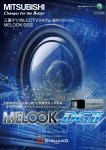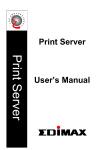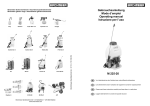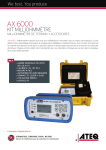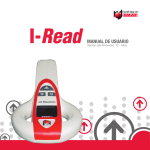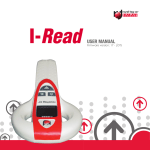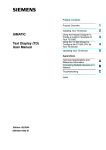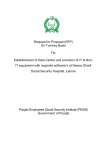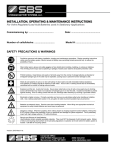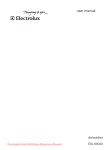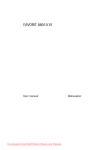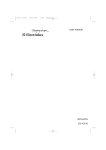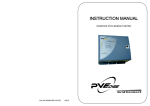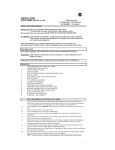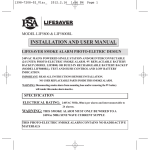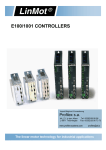Download section 2 - the Metallisation Shop
Transcript
METALLISATION LIMITED PS50M 50KW PLASMA SYSTEM OPERATING MANUAL & SPARE PARTS LISTS Issue: Supersedes: 02/02-11 01/10-10 Metallisation Limited Equipment Manual Amendment Register PS50M 50Kw Plasma System New Issue Number 01/10-10 02/02-11 Description Of Modifications New manual. Update leak test procedure Section Amended All 2.6 Amended By C. Arrow A. Jones Before using the Equipment, read and understand this operating manual. In particular, refer to the Safety Precautions detailed in Section 2. Under NO circumstances should any modifications be made to the equipment without prior written approval from Metallisation CONTENTS SECTION 1. INTRODUCTION 1.1 1.2 1.2.1 1.2.2 1.2.3 1.2.4 1.2.5 1.2.6 1.2.7 SECTION 2. SAFETY 2.1 2.2 2.3 2.4 2.5 2.6 2.7 2.8 SECTION 3. Electrical Radiation Hazards Atmospheric Pollution Explosion Noise Plasma Leak Test Procedure General Liability SUPPLIES REQUIRED FOR A PLASMA INSTALLATION 3.1 3.2 3.3 3.4 SECTION 4. The Plasma Spraying Process General Description of Equipment Plasma gun series PLA 5000 Power supply unit series PS50M-DIPS Water chiller unit Powder feed unit (hopper) series 2007MF-PF Control console series PS50M 50Kw System interconnections Communication Connections Water Air Gases Electricity INSTALLATION 4.1 4.2 4.3 4.3.1 4.3.2 4.3.3 4.3.4 4.3.5 4.3.6 4.4 4.4.1 4.4.2 4.4.3 4.5 4.5.1 4.5.2 4.6 4.7 4.8 The Plasma Spray Gun Power Supply Unit Powder Feed Unit Supplies required Powders Multiple feed Powder change Powder hoppers Pipe work Control Console Controls TD200C Gas Box Annunciator Interlock system Installation Basic HMI Operation Pre-Operation Checks Location of Power Supplies Power Unit Protection Chiller 4.9 Powder Feeder SECTION 5. OPERATION 5.1 5.1.1 5.2 5.2.1 5.2.2 5.3 6.4.1 6.4.2 6.4.3 6.4.4 SECTION 6. Operating Instructions Detailed Operating Procedure Use of Cooling Supply required Cooling jets Common Spray Faults and Causes Clogging or Pulsing of Powder Material Build Up at Gun Orifice Poor Adhesion of Coating to Substrate Material Loose and Soft Coatings with Unmelted Particles SPRAYING CONDITIONS 6.1 6.1.1 6.1.2 6.1.3 6.1.4 6.1.5 6.1.6 6.2 6.2.1 6.2.2 6.2.3 6.2.4 6.2.5 6.2.6 6.3 6.3.1 6.3.2 6.3.3 6.3.4 6.4 6.5 6.5.1 Substrate Preparation Surface Treatment Degreasing Masking for Grit blasting Grit blasting Masking for plasma spraying Recommended Masking Materials Spraying Technique Spraying distance and angle Coating thickness and adhesion Substrate cooling Powder size Powder Melting Powder feed rate Powder Handling Storage and use Hopper cleanliness Plasma gun Handling equipment Gun Handling Powder Feed Check Minimum settings SECTION 7. PF-MET POWDER FEEDER 7.1 SECTION 8. POWER SUPPLIES 8.1 SECTION 9. Plasma Spray Gun Series PLA 5000 Front electrode Rear electrode 'O' rings Disassembly Reassembly Powder Feed Unit Power Supplies Chiller Pipework PARTS LIST 11.1 11.2 11.3 11.4 SECTION 12. Introduction OPERATOR MAINTENANCE 10.1 10.1.1 10.1.2 10.1.3 10.1.4 10.1.5 10.2 10.3 10.4 10.5 SECTION 11. Introduction WATER CHILLER 9.1 SECTION 10. Introduction Plasma Spray Gun Series PLA 5000 and PLA5000-90 Internal Nozzle Schematic External Nozzle Schematic Pistol Powder Hose Fittings CIRCUIT DIAGRAMS SECTION 1 THE METALLISATION PS50M 50Kw INTRODUCTION SECTION 1 CONTENTS 1.1 1.2 1.2.1 1.2.2 1.2.3 1.2.4 1.2.5 1.2.6 1.2.7 The Plasma Spraying Process General Description of Equipment Plasma gun series PLA 5000 Power supply unit series PS50M-DIPS Water chiller unit Powder feed unit (hopper) series 2007MF-PF Control console series PS50M 50Kw System interconnections Communication Connections 1.1 The Plasma Spraying Process Plasma is the term used to describe gas which has been raised to such a high temperature that it ionises and becomes electrically conductive. In the case of plasma spraying, the plasma is created by an electric arc burning in the nozzle of the plasma gun; the arc gas is formed into a plasma jet as it emerges from the nozzle. (see Fig 1). The material to be deposited is in powder form. Particles are injected into the plasma jet where they melt and then strike the work piece at high velocity to produce a strongly adherent coating. The work piece remains relatively cool since the plasma jet is localised at the gun, whereas in chemical flame spraying processes the work piece is enveloped by a high intensity flame which can cause significant deformation. Materials that can be sprayed include metals, ceramics and plastics Fig. 1 1.2 GENERAL DESCRIPTION OF EQUIPMENT 1.2.1 Plasma Guns Series PLA 5000-90 A compact unit only 110mm long with the supplies supplied at 90 degrees to allow access into small spray areas. The pistol is capable of continuous operation with a power consumption of up to 50Kw. 1.2.2 Power Supply Unit PS50M-DIPS The PS50M-DIPS is an inverter power supply which gives a maximum power output of 50Kw, 50Vdc @ 1000 Amps. The D.C. Power Supply Units are designed to run off normal factory three-phase electrical supplies. This unit is capable of either medium or high current operation to enable it to be used with a variety of gases. Current is continuously variable from the control console. It is possible to link two power units together to further enhance the flexibility of the system. By linking the units it is possible to obtain high power outputs of either 2000A @ 50V or 1000A @ 100V. 1.2.3 Water Chiller Unit Because of the very high plasma temperatures that are attained, it is essential that the PLA series torches and their associated leads be cooled by a constant flow of de-mineralised water. The water chiller provides this cooling. The unit is a closed circuit cooler complete with high pressure recirculation pump. The PS100M*CU controller ensures that there is an adequate water flow of a minimum delivery of 12 Litres per minute, before the system can be operated. 1.2.4 Powder Feed Unit 2007MF-PF This vital system element is an electronically controlled positive displacement feeder which provides precise and consistent powder feed for a wide range of rates and material types. The 2007MF-PF features digital read-outs to clearly indicate the carrier gas flow and feed screw RPM. These parameters are typically set by the PS50M control console; however the powder can also be used as a stand alone unit controlled by the panel switches. 1.2.5 PS50M 50Kw Operating Screen Figure 1 Main Operating Screen The PS50M*CU Controller is a touch screen HMI used to provide precision control of the power supply units, system cooling, powder feeders and gases used All spray parameters can be easily controlled and monitored from this controller as well as call on a library of installed parameters from Microsoft Excel. The controller can also call the relevant robot program, check it is correct and monitor its progress. A Bar-code system can also be incorporated to call for spray parameters and be tied to Job Numbers and Quality Reports. There are a number of safety interlocks within the system to prevent accidental damage to the equipment or injury to the operator. All gas pressures and flows are monitored as is the coolant water pressure, flow and temperature. Any fault conditions that may arise will be displayed on this screen and must be rectified and reset prior to continuing operation. 1.2.6 Water and Power Connections Chiller control line 3-phase 415 power Chiller Chilled water Single-phase 240vac Gas Control box Ps50MCu Auto/Dual Combined water and power PS50M*IPS-A/Dual DC Output Power Plasma Torch 1.2.7 Communication Connections Powder feeder PF-Met-Auto Robot Contr ol box Gas Control box Ps50MCu Auto/Dual Siemens cabling HMI Controller PPI bus Powder feeder PF-Met-Auto SECTION 2 THE METALLISATION PS50M-50Kw SAFETY SECTION 2 CONTENTS 2 Introduction 2.1 Electrical 2.2 Radiation Hazards 2.3 Atmospheric Pollution 2.4 Explosion 2.5 Noise 2.6 Plasma Leak Test Procedure 2.7 General 2.8 Liability 2 INTRODUCTION The operation of plasma generators for spraying is no more dangerous than that of many other industrial machines, but the dangers which are present, although not great, should be recognised and care taken continuously to prevent accidents. It must be assumed that the average person is not aware of all the hazards involved, as is the case with other equipment capable of generating large amounts of energy. Some of the potential sources of danger are listed below: 2.1 Electrical The power sources are very similar to welding generators and the plasma arc is similar to some welding arcs. Consequently, the precautions normally taken with electric arc welding equipment are applicable: Take care not to short circuit across the generator terminals or other parts of the DC circuit as this can cause severe arcing. Only qualified personnel should be used when work is to be carried out any electrical equipment. Refer to the relevant manual for further details regarding the Power Supply. 2.2 Radiation Hazards Eyes and skin of personnel exposed to radiation from the plasma gun should be protected from ultra-violet radiation. Protective glasses shade 10 minimum must be used. No area of skin should be exposed to the radiation for continuous periods. Therefore the operator should be completely covered. 2.3 Atmospheric Pollution When using a plasma gun for spraying, an amount of metal or ceramic dust will contaminate the air. Under normal operations, forced ventilation should be used. When this forced extraction can contaminate outside the spraying area it may be necessary to use filters or water wash tanks to clean the extracted air. Care must be taken when spraying materials which can produce dangerous vapours (e.g. lead and radioactive materials). 2.4 Explosion Always check that water is not leaking into the arc chamber; as this could be decomposed to oxygen and hydrogen, the recombination can be explosive. When using hydrogen, check all connections and hoses for leaks with an inert gas before initial use, and keep a check at regular intervals. 2.5 Noise When using argon arc gas, the plasma gun is not particularly noisy, but ear muffs will be needed and the installation should preferably be away from offices and quiet areas. When using nitrogen or hydrogen there is a much higher noise level. Note The equipment detailed in the above information will produce levels of noise and dust that will require safety measures to be taken by those using the equipment. It will use pressurised gases and may also use flammable gases; therefore careful consideration should be given to the positioning of the equipment. 2.6 Plasma Leak Check Procedure This procedure must be carried out on a regular basis to ensure safe and correct operation of the equipment. NOTE: Care must be taken when using liquids around electrical circuitry due to the possibility of an electric shock. 1) Disconnect the pistol from the plasma gas hose and fit a suitable pressure gauge (part no 1539). 2) Disconnect the powder feeder from the carrier gas hose and fit a suitable pressure gauge (part no 1539). 3) Make sure the Nitrogen and the Argon gases are switched on and the regulators are set to 60 psi. If Hydrogen is used replace with an inert gas i.e. Nitrogen. 4) Release the “E-Stop” if depressed and enter ‘Diagnostics Mode’ by disconnecting terminal switch T10. 5) The Message Screen will say ‘Diagnostics Mode Enabled’, press Coolant On and reset faults. 6) The area around the coolant button will now be green and various functions can now be tested. 7) Press “Argon Gas On” allowing the gas pressures to stabilise. 8) Press “Argon Gas Off” and switch off the gases at the bottles /gas supply. 9) Increase both regulators by one turn of the regulator valve. 10) Press “Argon Gas” on the plasma console and watch the pressure gauges. 11) If they go UP you have a gas leak from the bottle / supply into the system. Fix by changing the bottles / valve. 12) If they go DOWN you have a leak in the system. 13) Use leak test liquid or soapy water to test for leaks. Coat all the gas pipe-work where a leak could be present. Cover all areas until bubbling of the liquid identifies a leak. NOTE Check hoses as well. 14) Fix leak and wipe excess liquid from system. 15) Re-test system for leaks by following from step three above. 16) Be sure that all hoses are reconnected and the gas regulators are reset correctly before resetting the console. 17) To test the secondary gas line, any pressure in the system must be released and the above procedure repeated for the required gas line. 2.7 General Normal safety rules should be obeyed: for example i) All gas bottles must be safely stowed. Keep bottles chained so that they cannot fall over ii) Keep combustible materials away from the spraying area as molten particles can be very hot iii) Run hoses and cables in ducts or at least where they cannot be trodden on or tripped over iv) Warn the operator before spectators enter the spraying area v) Turn off water, gas and power supplies when not in used vi) Smoking is forbidden when hydrogen is being used 2.8 Liability Metallisation Limited disclaims any liability and assumes no responsibility for damages or injury resulting from the installation and use of plasma generators and/or components. SECTION 3 THE METALLISATION PS50M 50Kw SUPPLIES REQUIRED FOR A PLASMA INSTALLATION SECTION 3 CONTENTS 3.1 Water 3.2 Air 3.3 Gases 3.4 Electricity 3.1 Water The PS50M 50Kw requires a water cooler to supply the following minimum cooling requirements:Cooling water is required for the gun and its flexible power cables. A flow rate of 43 Litre/Min at a delivery pressure of 5 bar is recommended. This gives a flow rate through the pistol of 12 Litre/Min for the PLA5000 Cooling water temperature at gun inlet must not exceed 16 oC. Cooling water for the Plasma must be Demineralised. 3.2 Air (for work piece cooling) Clean, dry, oil free air must be used at all times. The air may be considered as dry and oil free if an air jet can be directed into an industrial tissue for at least 10 minutes without any trace of oil or moisture being detected on the tissue. A 5 micron filter fitted in the air line will ensure cleanliness of the air used. 3.3 Gases Gas delivery pressure from the bottle should be regulated at 4bar (60psi). The purity of the gases used is important for coating quality and electrode life. Recommended purities are:ARGON NITROGEN HYDROGEN HELIUM - 99.995% High purity 99.9% Oxygen free High purity 99.992% Industrial Standard Before starting the gun the gas line should be purged of air. This is important if new gas bottles have been fitted or the gun has not run for some time. Note: The secondary gas must be turned on even if it is not to be used to satisfy supply safety interlocks 3.4 Electricity Water Chiller Power Unit Console Ancillaries - 3 phase 400V 50Hz 19.2 A / Phase - 3 phase 230 - 400V 50 / 60 Hz 112 - 63 A / Phase - 240V 50Hz - as required If customer's electrical supply voltage differs from the above a special power supply will be provided to order. Further information on requirements for installation of plasma spray equipment may be obtained from Metallisation Limited, Pear Tree Lane, Dudley, West Midlands SECTION 4 THE METALLISATION PS50M 50Kw SYSTEM COMPONENTS AND INSTALLATION SECTION 4 CONTENTS 4.1 4.2 4.3 4.3.1 4.3.2 4.3.3 4.3.4 4.3.5 4.3.6 4.4 4.4.1 4.4.2 4.4.3 4.5 4.5.1 4.5.2 4.6 4.7 4.8 4.9 The Plasma Spray Gun Power Supply Unit Powder Feed Unit Supplies required Powders Multiple feed Powder change Powder hoppers Pipe work Control Console Controls TD200C Gas Box Annunciator Interlock system Installation Basic HMI Operation Pre-Operation Checks Location of Power Supplies Power Unit Protection Chiller Powder Feeder 4 SYSTEM COMPONENTS 4.1 Plasma Spray Gun The gun consists of a copper front electrode (anode) containing a nozzle and a rear electrode (cathode). Both are water cooled and physically separated by an insulator, which is shaped internally to form the arc gas chamber. Arc gas is fed into the chamber and escapes through the anode nozzle. An arc is struck between the two electrodes, ionises the gas and produces a plasma jet as it emerges from the nozzle at an extremely high temperature. Powder is fed into the plasma by a second gas stream fed into the nozzle or just after the plasma emerges from the nozzle. An exploded view of the gun is shown section 12. Procedures for setting up are given under separate titles in section 6. Always ensure that any unused powder feed inlet points are blocked off so that air is not drawn into the plasma system. Alternative anode and external powder feed attachments are available with either single or double powder inlets, and anodes with either 6mm, 8mm or 9.5mm nozzles can be supplied to order. Please refer to "Parts list” in this manual. 4.2 POWER UNITS The inverter power supplies, depending on configuration, are capable of producing up to 2000A with an open circuit voltage of 92Vdc or 1000A with an open circuit voltage of 180Vdc. 4.3 POWDER FEED UNIT 2007MF-PF 4.3.1 Supplies Required Single phase 240Vac power supply and a carrier gas supply provided either from the PS50M-CU, or, if the feeder is to be operated as a stand alone unit direct from a supply cylinder. The RS485 Bus Lead also needs to be connected if the feeder is to be operated by the control console. 4.3.2 Powders All powders should be:Clean, dry and free from lumps Free flowing Within size and distribution specification Should be stored in a warm dry atmosphere. A photograph drying cabinet is ideal. Spray powders should not be left in the feeder when equipment is not in use or powder will compact and absorb moisture. This causes unreliable powder flow and reduces the deposition efficiency. 4.3.3 Multiple Feed The melting characteristics of a powder determine whether it is fed directly into the plasma inside the front electrode nozzle (INTERNAL), or via feed ring adjacent to the nozzle exit (EXTERNAL). Refer to section 7.5.2 / 7.5.3 for parameters. 4.3.4 Powder Change If the system is used for spraying both ceramics and metals it is advisable to have two powder feeders / Dual system, one for each type of powder to minimise cross contamination and the need for cleaning. After use, or when changing powders the powder system must be cleaned using the procedure given in Section 7.3.2. 4.3.5 Powder Feeders A Powder Feeder Unit Type 2007MF-PF is supplied with the system. In practice the feeder should be positioned near to the spray gun and the pipe between hopper and gun should be used as supplied. 4.3.6 Pipework Pipes should be kept clean, dry and free of sharp bends or constrictions. The pipework supplied must be used; in particular the pipe lengths between the gun, powder feeder unit and control console are critical and should not be altered. The pipework colour code shown under Section 11.5 must be observed. 4.4 THE CONTROL CONSOLE The Control Console Unit acts as a control centre for the equipment and should be positioned so that the operator can see the gun in operation, through dark glasses (minimum shade 10). 4.4.1 Controls The console contains:i) Gun monitoring and power control ii) Monitoring and controls for arc gas(es) and powder gas sequence. 4.4.2. TD200C Gas box annunciator The system may also be operated from the small annunciator fitted to the front face of the gas box. With the exception of the automatic functions such as program or parameter selection it is possible to operate the system completely but in a manual mode from this screen. The process is fully described in section 6.4. 4.4.3 Interlock System Automatic interlocks are incorporated in the control console to prevent damage to the equipment and provide protection for the operator. The powder feed system will also not operate unless the primary gas is 'ON'. The power unit cannot be started unless both arc gas and water flows are above minimum operation values to protect the gun from damage. If either of these flows are to low the system will shut down and go into a fault condition. At no time should any of these interlock devices be bypassed. They are for the protection of the operator as well as the equipment. 4.5 INSTALLATION It is advisable for installation and commissioning to be carried out by Metallisation technical services only. However, the safety circuit can be modified to suit ‘stand alone’ or ‘integrated’ systems. (Refer to section twelve for details). But please note that this is only to be carried out by ourselves or suitably trained personnel. It is not recommended that the system be altered in any other way without prior consultation with Metallisation Ltd. Only replacement parts supplied by Metallisation Ltd. should be used . For the installation of the power unit, please refer to the PS50M-DIPS user manual. Attach the control leads and the power cables from the power supply to the console. ENSURE POLARITY IS OBSERVED! Also attach the cooler, powder feeder and the pistol to the control console. Make sure all connections have been made. Connecting all supply hoses and cables as per (1.2.6 and 1.2.7 Water, Power and Communication Interconnections). Before operating the system it is important to be familiar with the operation of the HMI Display screen. 4.5.1 Basic HMI Operation The screen is made up of a variety of text boxes used to either display or enter parameters and other useful information. Boxes with black backgrounds are parameter boxes for setting and observing operating values and are clearly labelled e.g. VOLTAGE, CURRENT PRIMARY GAS etc. Within each black box there are two numbers. The upper number in smaller font indicates the chosen value for the parameter. The lower number in larger font indicates the actual value achieved at any time. Naturally if a process is not active at any time the related parameter will not be read back and will be zero or close to it. Beneath each black box there are three smaller boxes marked “+” SET and “.” + and – raise and lower the chosen value by increments as long as the box is pressed. Tapping the SET box brings up a numerical keypad to allow a value to be entered directly and accepted by tapping the OK box at which time the value will change and the keypad will disappear. N.B. There are no such boxes associated with the “VOLTAGE” display as this a resultant parameter rather than being one which may be pre-set. Above the lower row of parameter boxes there are a series of smaller check boxes used to decide on Boolean options such as which of the two powder feeders should be used, which primary gas and which secondary gas. Also in this region are check boxes indicating the type of spray gun being used. Some parameters are not appropriate for some pistol types. For instance the PLA5000 cannot be used with Nitrogen primary gas so both check boxes cannot be ticked. If the PL5000 is selected and the Nitrogen primary is tapped it will briefly indicate Nitrogen but then quickly revert to Argon. The list of proscriptions is contained in the appendix. In manual mode at the bottom of the screen are a series of green and red buttons. These buttons when operated sequentially generally from left to right bring the system from a standby condition into full operation. Towards the top of the screen there is a message box which provides useful information as to the status of the system and also advises on what the next operation might be. For instance the coolant must be turned on first and the screen will say “Turn coolant on”. Having tapped the coolant on button at the bottom of the screen the message will change to “Coolant running” and then “Press Primary Gas On” which is the next logical step and so on. It will also suggest the options of turning things off when they are on. This is achieved by tapping the appropriate red button. 4.5.2 Pre-Operation Checks It is advisable to follow the following preliminary checks at first installation, if the system is moved or has been unused for a period of time. Check that the E-Stop works and that it also disables the power supplies. Turn the power to the power supply on. Turn the power to the cooler on. Turn the power to the powder feeders on. Turn the main power on and start up the HMI operating screen. Press the coolant on button, the surrounding area will turn green. Restrict the water flow through the system and ensure it shuts down if the flow drops to below 12 L/m. this should be set and checked with the aid of a flow meter. NOTE: Ensure that the water flow through the pistol is a minimum of 12 Litres/Min other wise damage to the pistol will occur. Turn the extraction, gases and coolant on. Press the coolant button; the surrounding area will turn green. Press the “Primary Gas On” button and Argon will begin to flow at 20l/min, this is a preset value that cannot be adjusted. If the system is to be operated with Nitrogen, it will first feed Argon until the system detects a spray current, at this time it will change over to Nitrogen. If the gas flow varies by 0.5l/min to its set value at any point during operation the system will shut down and display a gas fault. Turn the primary gas off. Leak Test the system as per (2.6 Plasma Leak Test Procedure) 4.6 Location of Power Supplies The power unit should be placed in a convenient position where adequate spacing is available for the passage of air cooling. The location should be such that a minimum amount of dust and dirt contamination is likely. Access may be required to the units for maintenance. 4.7 Power Unit Protection Refer to dedicated manual for information. 4.8 Chiller Refer to dedicated manual for information. 4.9 Powder Feeder Refer to dedicated manual for information. SECTION 5 THE METALLISATION PS50M 50Kw OPERATION SECTION 5 CONTENTS 5.1 5.1.1 5.2 5.2.1 5.2.2 5.3 6.4.1 6.4.2 6.4.3 6.4.4 Operating Instructions Detailed Operating Procedure Use of Cooling Supply required Cooling jets Common Spray Faults and Causes Clogging or Pulsing of Powder Material Build Up at Gun Orifice Poor Adhesion of Coating to Substrate Material Loose and Soft Coatings with Unmelted Particles 5.1 OPERATING INSTRUCTIONS 5.1.1 Detailed Operating Procedure The system can be operated in a different number of ways, manually from the HMI or TD200C or automatically from the HMI. The system may be operated from either the TD200C mini screen on the gas box or more usually from the touch screen HMI. The HMI offers a much wider range of options and controls as detailed below. The screen is made up of a variety of text boxes used to either display or enter parameters and other useful information. Boxes with black backgrounds are parameter boxes for setting and observing operating values and are clearly labelled e.g. VOLTAGE, CURRENT PRIMARY GAS etc. Within each black box there are two numbers. The upper number in smaller font indicates the chosen value for the parameter. The lower number in larger font indicates the actual value achieved at any time. Naturally if a process is not active at any time the related parameter will not be read back and will be zero or close to it. Beneath each black box there are three smaller boxes marked “+” SET and “.” + and – raise and lower the chosen value by increments as long as the box is pressed. Tapping the SET box brings up a numerical keypad to allow a value to be entered directly and accepted by tapping the OK box at which time the value will change and the keypad will disappear. N.B. There are no such boxes associated with the “VOLTAGE” display as this a resultant parameter rather than being one which may be pre-set. Above the lower row of parameter boxes there are a series of smaller check boxes used to decide on Boolean options such as which of the two powder feeders should be used, which primary gas and which secondary gas. Also in this region are check boxes indicating the type of spray gun being used. Some parameters are not appropriate for some pistol types. For instance the PLA5000 cannot be used with Nitrogen primary gas so both check boxes cannot be ticked. If the PLA5000 is selected and the Nitrogen primary is tapped it will briefly indicate Nitrogen but then quickly revert to Argon. The list of proscriptions is contained in the appendix. The HMI can be used in manual or fully automatic mode. In manual mode at the bottom of the screen are a series of green and red buttons. These buttons when operated sequentially generally from left to right bring the system from a standby condition into full operation. Towards the top of the screen there is a message box which provides useful information as to the status of the system and also advises on what the next operation might be. For instance the coolant must be turned on first and the screen will say “Turn coolant on”. Having tapped the coolant on button at the bottom of the screen the message will change to “Coolant running” and then “Press Primary Gas On” which is the next logical step and so on. It will also suggest the options of turning things off when they are on. This is achieved by tapping the appropriate red button. Automatic mode Above the “FEED RATE” box there is a set of red boxes. These deal with inputting information for automatic operation. In production usage it is assumed that jobs and their resultant spray materials, parameters and robot programs will result from the selection of a barcode and this is the sequence defined below. Tap on the “Select Barcode” button. All buttons pertaining to manual operation will disappear from the bottom of the screen to be replaced by “SPRAY SEQ” start and stop. A text box will open awaiting input from the barcode reader. Place the reader against the barcode on the PCC sheet and press the button beneath the handle. The barcode reader should beep and the number be entered into the text box. If the barcode reader fails to read the PCC number may be entered manually into the textbox. Tap OK and the text box will disappear and the system will start searching in an Excel file (C:\bes\inductiondata1.xls) for all possible job numbers that correspond to this PCC number. .PLEASE BE PATIENT AS THIS COULD BE A LARGE FILE. It will then search another file (C:\bes\plasma setup.xls) for occurrences of this job number and associated operation numbers The possible job numbers/ operation numbers will then be displayed in a window on the screen. Select the correct one by tapping the number. A text box will be displayed in the centre of the screen showing notes attached to the operation number. These are intended to assist the operator in confirming that this is the correct operation number. Tap OK or CANCEL as appropriate. If cancelled then start the process again. Assuming OK was tapped the PCC number will appear in the red box that previously said “Load from Excel” and all the required parameters including gun type, robot program etc will be loaded. At the top of the screen directly above the Metallisation image is a text box confirming the Job Number, Operation Number, Robot program, powder type, Gun type and other notes pertaining to the job again helping to ensure that the correct coating is applied in the correct way. Note that for all of this the screen background has been grey and in the top left corner were the words “BOND COAT SETTINGS”. This is because the check box labelled 1ST at the top left of the red automatic boxes is checked. A full set of parameters and operations is available in a second screen which is activated by checking the box marked 2nd. When this is done the screen changes to a cyan colour and the words “TOP COAT SETTINGS” are displayed at the top left. In this case exactly the same procedure is followed to load another parameter set to be used as the top coat Edit Mode In either screen it is possible to edit the settings and parameters while running but this will be recorded on the quality report that is automatically produced at the end of each run. To do this tap the EDIT ON red button and all the start/stop buttons will re-appear at the bottom of the screen. In addition the red EDIT ON button will be replaced by a yellow EDIT OFF button signifying that it is now in edit mode. To return to the automatic mode tap this button and the screen will revert to its original appearance. However the EDIT flag will remain set in the quality report. Annunciator operation As has been said the whole system with the exception of the automatic functions can be operated from the annunciator on the gas box. The surface of the annunciator contains several membrane switches which allow the unit to be set up and operated. The green and red buttons are almost self explanatory and turn on and off the various functions while spraying in a similar way to the HMI screen in Manual mode. The coolant button starts the chiller and must be held down until the Message coolant running is displayed. Once it is released upon pressing a second time the chiller will be turned off. The ignition button only needs to be pressed once and is only functional if the main power has been turned on. The yellow buttons and the up/down arrows are used in setting up and viewing the parameters. Upon powering up the system will initialize and then go into the operator mode expecting the operator to turn on the coolant , primary gas main power etc, etc. It will also show if any faults such as low gas pressure etc. is present. If so the fault must be rectified and afterwards the “Shift” button must be held down for three seconds to clear the fault. However in order to run the systems parameters must be entered. Parameter entry. Press the Menu button down arrows. The Text will change to a list of parameter types that may be scrolled through with the up SET GASES SET CURRENT SET POWDER FEEDER SET AIR JETS To select one of these scroll to it and press “ENTER” Some Menus such as SET GASES have sub-menus in this case of primary gas, secondary gas and carrier gas and to select one of these scroll again and press ENTER again. Once you are looking at the parameter you wish to change then it can be highlighted with the ENTER button and its value changed with the UP/DOWN arrow buttons. Note that if the arrow button is held down its effect accelerates so one can easily overshoot the desired value. Once you have the desired value press ENTER once more to un-highlight the parameter. To leave a menu press ESCAPE By scrolling through and setting as required the values in the menus and sub-menus all the required parameters may be set in advance. By pressing ESCAPE enough times you will then arrive back at the Operator screen. Diagnostics In addition to setting all the parameters these can also be read in real time while spraying. From the Operator screen press menu and then scroll until you highlight the word DIAGNOSTICS and press ENTER. You are now looking at a scrollable list of parameters displaying their values. Simply scroll up and down to view the chosen parameter. To leave the DIAGNOSTICS menu press ESCAPE. Quality reporting When operating from the HMI a quality report is begun when the ROBOT START event takes place and terminated and compiled when the ROBOT STOP event takes place. The report contains the PCC number, serial number, job and operation number and various other details as well as a running record of the spray parameters and any errors or edits that have occurred. The frequency of the parameter recording interval is chosen from the value contained in the file C:\BES\REPORTTIME.DAT. Once the ROBOT STOP event takes place a message will appear saying COMPILING PLEASE WAIT and at the end of this process the system will have produced an Excel file in the directory C:\BES\REPORT. The filename of the report will be the PCC number followed by the date and the number of seconds since midnight for that date. In this way every file is unique and can easily be identified. 5.2 USE OF COOLING JETS 5.2.1 Supply Required Clean, dry, oil-free air supply (see section 3.2) with a delivery pressure of 30-40psi. 5.2.2 Cooling Jets These are jets that are directed at the work piece to cool it. The jet does not impinge on the work piece in the region of spray or interfere with the spray pattern in any way. The air flow rate is the maximum obtainable. They are of particular use on low melting point, or very thin substrates. In the latter case it is often directed at the back of the work piece opposite the spray area. 5.3 COMMON SPRAYING FAULTS AND CAUSES 5.3.1 Clogging or Pulsing Powder Feed Powder not clean, dry or contains lumps Powder too fine Constriction in powder feed pipe Powder feed rate too slow Particle shape unsuitable 5.3.2 Material Build Up at Gun Orifice Wrong gas flow rates Feeder setting too high Powder too fine Powder too low melting point - use external feed 5.3.3 Poor Adhesion of Coating to Substrate Material Poor surface preparation Overheating of base material Wrong gas settings Wrong powder size distribution Wrong work piece to gun distance Coating too thick 5.3.4 Loose and Soft Coatings with Unmelted Particles Wrong powder size distribution Small particles vaporising and recondensing Spray distance too great Exhaust system not removing overspray Wrong gas setting Wrong power setting Powder feed rate too high SECTION 6 THE METALLISATION PS50M 50Kw SPRAYING PROCEDURES SECTION 6 CONTENTS 6.1 6.1.1 6.1.2 6.1.3 6.1.4 6.1.5 6.1.6 6.2 6.2.1 6.2.2 6.2.3 6.2.4 6.2.5 6.2.6 6.3 6.3.1 6.3.2 6.3.3 6.3.4 6.4 6.5 6.5.1 Substrate Preparation Surface Treatment Degreasing Masking for Grit blasting Grit blasting Masking for plasma spraying Recommended Masking Materials Spraying Technique Spraying distance and angle Coating thickness and adhesion Substrate cooling Powder size Powder Melting Powder feed rate Powder Handling Storage and use Hopper cleanliness Plasma gun Handling equipment Gun Handling Powder Feed Check Minimum settings 6.1 SUBSTRATE PREPARATION 6.1.1 Surface Treatment To accept sprayed coatings the substrate surface must be roughened and be scrupulously clean of grease and scale. 6.1.2 Degreasing Remove any paint completely by pickling or scraping. Remove any loose rust with a wire brush. Degrease in a vapour degreasing tank. If it is impossible to degrease in a tank, wash work piece in trichloroethylene. Only do this in a well ventilated room. After degreasing do not touch the work surface until it has been sprayed. Take care that the surface remains grease free. Cotton gloves can be worn to prevent contamination for the surface by finger marks. 6.1.3 Masking for Grit blasting To protect machined surfaces and to reduce the adhesion of coatings in unwanted areas it may be necessary to mask work pieces for Grit blasting. Masks may be made from thin sheet metal or vinyl adhesive tape. 6.1.4 Grit blasting Gritblast air supply must be clean, dry, oil free (See Section 3.2). White alumina grit (20 grade) is recommended for the preparation of most metal substrates For thinner section materials, where distortion is to be avoided a lighter grit or lower air pressure must be used. At all times grit must be clean and sharp. Do not contaminate grit with rust. If the work piece is rusty, blast in two stages, using old grit to remove rust and clean grit for final preparation. Gritblast normal to the substrate surface at a distance of 50-80mm until the surface appearance remains constant. After Grit blasting remove any surface dust with a clean air jet before spraying. Do not touch grit blasted surfaces with bare hands. Spraying must be done within one hour, otherwise grit blasting must be repeated. Remove any masking not suitable for spraying. 6.1.5 Masking for Plasma Spraying To protect areas within the field of spray it will be necessary to mask off to prevent coating adhesion. There are three basic methods:i) Physical masks of thin metal held between the gun and the work piece. ii) Physical masks of thin metal sheet or special adhesive tape fixed to the work piece. Plugs should be used to protect holes, grooves etc. iii) Paint on type barriers such as Metallisation Sprayshield. The choice of masking method will depend on the particular application. Normal adhesive tapes are not suitable for masking while spraying unless they are protected by a metal guard. 6.1.6 Recommended Masking Materials Sheet metal for grit blast and spraying. Vinyl adhesive tape for grit blasting only. Sprayshield for spraying only. Vinyl adhesive tape protected by a metal guard for spraying. Adhesive glass fibre tape for spraying. 6.2 SPRAYING TECHNIQUE Metallisation Limited Plasma Spray System is capable of consistently producing good quality coatings for a very wide range of materials. To obtain such results great care must be taken to ensure that work pieces are properly prepared and the optimum spraying conditions for each powder are used. 6.2.1 Spraying Distance and Angle At all times the work piece surface should be normal to the spray jet. Variations from the normal of greater than 15o will result in reduced adhesion between coating and substrate, and a greater degree of porosity. The spray distance and traverse rate should remain constant while spraying, so for high quality work the gun should not be hand held. 6.2.2 Coating Thickness and Adhesion The bond between coating and substrate becomes weaker as the coating thickness is increased. A final coating thickness of 0.4mm should be considered as a maximum for most applications, and coatings thinner than 0.1mm thick will not completely cover the surface. It is possible to build up thick coatings by paying special attention to substrate preparation and cooling, and by applying each layer of coating as thinly as practicable. The maximum thickness obtainable is best found by producing a series of test samples using different spraying techniques. 6.2.3 Substrate Cooling Best results are obtained when the work piece is kept as cool as possible. When spraying metal coatings a spraying distance of 75 mm is usually enough to prevent overheating above 100oC, but when spraying with ceramics this distance may be reduced to about 50mm. Substrate heating depends on the thermal capacity of the component and of the sprayed material. The use of cooling jets become important when spraying thin section work pieces to prevent overheating and distortion. These jets may be carbon dioxide, nitrogen or compressed air, but must always be clean, dry and oil-free 6.2.4 Powder Size Metallisation Surfacing Powders are all carefully graded for use with Metallisation Plasma Equipment. inappropriate powders can result in significant loss of deposit efficiency and coating quality. 6.2.5 Using Powder Melting For a particular spray powder the ability to melt particles is determined by the size and temperature of the hot region. The arc gas and current are the main variables in determining the size and temperature of the plasma and this combined with the powder gas flow rate governs the efficiency of melting the powder entering the gun. 6.2.6 Powder Feed Rate It has been found that deposition efficiency and coating quality are closely related. Thus powder feed rates must be kept below the level where deposition efficiency falls off. This varies with different materials and powder size distributions. The feed rate for a given powder is mainly dependant on the powder feeder setting and powder gas flow rate. 6.3 POWDER HANDLING 6.3.1 Storage and Use Keep all powders in a dry place, preferably in a heated cupboard. When using a bottle of powder, replace the lid of the container as soon as the amount required has been taken out. Damp powder will not flow uniformly. Any powder which becomes damp should be left in a heated cupboard and allowed to dry out. Do not leave powder in a hopper overnight, and clean out the powder feed pipe after use by removing it from the plasma gun and hopper and blowing it through with clean, dry air (See Section 3.2). 6.3.2 Hopper Cleanliness If more than one powder is used, care must be taken to avoid contaminating one material with another. If both ceramics and metals are used, the best method preventing contamination is to use a separate hopper for each kind of material. To clean out a hopper use the following procedure:Disconnect the powder feed hose from the pistol Turn on the primary gas at the main controller. Ensure the Feed & Vibrate button is not depressed to stop powder feed Push the vibrate only button to activate vibration Place a wide mouthed clean container under the drain fitting Remove the blanking cover from the powder drain fitting Collect the powder in the container as it falls from the hopper Remove the hopper lid and blow out the powder feeder hopper with clean, dry air. Wipe round with clean tissue cloth to remove any residue. Re-fit the lid and the powder drain fitting cover and re-set to normal operation Allow gas to blow down the torch powder supply hose until no more powder is blown free. Reconnect the pipe to the gun. 6.3.3 Plasma Gun When changing powders, inspect the inside of the gun for powder particles (use a torch). If powder is in the gun, take out the front electrode (see Section 11.1.4), and clean out the gas chamber with a jet of air). 6.3.4 Handling Equipment Keep scales, funnels, spoons etc clean at all times 6.4 GUN HANDLING The PLA 5000 Series Plasma Gun is best machine mounted. This ensures that coatings are of uniform thickness and that the distance between the plasma gun and the work piece is kept constant. The majority of plasma spraying applications will require the gun to traverse horizontally and/or vertically in directions parallel to the work piece at constant (but individually adjustable) velocities. This will facilitate the spraying of cylindrical or flat work pieces. The user should therefore make provision for both gun traverse and work piece rotation at the planning stage of an installation. 6.5 POWDER FEED CHECK It will be necessary to confirm the spray rate of a powder when ever a new powder is to be sprayed or once a week. The following procedure should be used to establish a spray rate : Weigh a clean empty bottle. Remove the powder feed hose from the gun. Operate the powder hopper and spray powder it to the booth until an even spray is observed. Push the powder feed hose (whilst feeding) into the neck of the clean empty bottle for one minute. Remove the powder feed hose immediately after one minute has elapsed. Switch off powder feeder. Re-weigh the bottle to establish the weight of material fed in one minute. Adjusted RPM on feeder (higher for more powder, lower for less) if necessary. Repeat to achieve the required feed rate. 6.5.1 MINIMUM SETTINGS A minimum arc gas flow rate of 20l/m should be observed in the interests of electrode life. Many powders will not flow uniformly if the powder carrier gas is reduced below 3l/m. SECTION 7 THE METALLISATION 2007MF-PF POWDER FEEDER SECTION 7 CONTENTS 7.1 Introduction 7.1 INTRODUCTION The Metallisation 2007MF-PF Powder Feeder is a carefully engineered and constructed machine, so with proper care and handling it should provide hundreds of hours of trouble-free service. To ensure satisfactory results, it is essential that the operator become thoroughly familiar with all parts of the feeder before attempting to operate it. Materials for the various components are carefully selected and all parts are accurately machined to close tolerances to provide optimum performance. After assembly, each powder feeder is carefully factory tested before it is finally approved for packing and shipment. Please refer to the dedicated 2007MF-PF Powder Feeder manual for full information on this item. SECTION 8 METALLISATION PS50M-DIPS POWER SUPPLY UNIT SECTION 8 CONTENTS 8.1 Introduction 8.1 INTRODUCTION The PS50M-DIPS Switch Mode Inverter Power Supply has been designed for use with the PS50M*CU control console and PLA5000 plasma pistol. Please refer to the dedicated PS50M-DIPS Power Supply manual for full information on this item. SECTION 9 METALLISATION PS50M-50Kw WATER CHILLER UNIT SECTION 9 CONTENTS 9.1 Introduction 9.1 INTRODUCTION The water chiller has been carefully selected to provide the PS50M plasma spray system with suitable cooling. It ensures the correct flow and temperature of water to the pistol at all times. Please refer to the dedicated manual for full information on the chiller system. SECTION 10 THE METALLISATION PS50M-50Kw OPERATOR MAINTENANCE SECTION 10 CONTENTS 10.1 10.1.1 10.1.2 10.1.3 10.1.4 10.1.5 10.2 10.3 10.4 10.5 Plasma Spray Gun Series PLA 5000 Front electrode Rear electrode 'O' rings Disassembly Reassembly Powder Feed Unit Power Supplies Chiller Pipework 10.1 Plasma Spray Guns Series PLA 5000 10.1.1 Front Electrode To ensure maximum electrode life it is advisable to inspect the nozzle every 20 hours for signs of pitting or erosion. Slight pitting may be polished out with grade 400 "Wet and Dry" carborundum paper. 10.1.2 Rear Electrode The rear electrode has a normal operating life of about 100 hours before it requires replacement. However it should be inspected every 20 hours for cracks or other damage. 10.1.3 'O' Rings The life of 'O' rings depends on the way they are handled and the frequency with which the gun is dismantled. It is not advisable to continue using 'O' rings until they fail. 'O' rings should be replaced every time the front electrode is renewed or the gun is completely dismantled unless they shown no signs of damage or permanent deformation. 'O' rings should be kept clean and LIGHTLY greased with silicone grease before use. Only use 'O' rings supplied by Metallisation Limited., since the ring grooves are designed for the ring material used. 10.1.4. Disassembly 10.1.4.1. Unscrew the rear electrode holder cover and let it slide back down the cooled conductor. 10.1.4.2. Holding the torch above the level of the cooler header tank and using two spanners, undo and remove the cooled conductors from the rear of the torch. Hook the two cooled conductors up above the header tank to avoid loss of coolant 10.1.4.3. After allowing the coolant to drain from the torch, point the torch downwards and remove the plasma gas hose from the torch, ensuring that water does not enter the gas hose. 10.1.4.4. Remove the two powder feed tubes from the adapters on the front cover, once again keeping the tubes dry. 10.1.4.5. Using a compressed air line blow out any remaining coolant by inserting an air jet into the electrode holder. 10.1.4.6. Working on a clean bench, remove the four cap screws from the rear of the torch and remove the rear cover. Note that the screws are retained behind the rear cover by four small 'O' rings. 10.1.4.7. Twisting the electrode housing if necessary, pull it out from the body. 10.1.4.8. Pull out the plastic water distribution ring and the gas baffle ring. 10.1.4.9. Undo the four screws holding the front cover in place and remove the front cover. 10.1.4.10. Using a thumb push the nozzle forwards and remove it from the torch body. 10.1.4.11. Unscrew the water baffle ring and remove it. 10.1.5. Reassembly. 10.1.5.1. Before reassembly, inspect all the 'O' rings and replace them if there is any sign of cuts or permanent compression. Serious damage will be done to expensive parts if water is allowed into the arc region. Therefore systematic 'O' ring replacement is the safest policy. 10.1.5.2. Inspect the rear electrode for cracks or excessive wear and replace if necessary. The electrode itself is removed from the electrode holder using the special peg spanner provided. 10.1.5.3. Inspect the nozzle for gouging and general wear and replace as necessary. Thereafter, re-assembly is the reverse of disassembly, bearing the following points in mind. 10.1.5.4. All 'O' rings must be lightly lubricated with 'O' ring lubricant without allowing lubricant into the nozzle bore. 10.1.5.5. When fitting the gas baffle ring this must be pressed fully home into the torch body, before fitting the water distribution ring. 10.1.5.6. When fitting the front and rear covers, tighten the screws progressively in a diagonal pattern to ensure that the covers are pulled down evenly. This is particularly important for the front cover and this creates an electrical connection which will be expected to carry 1000 amperes. 10.1.5.7. When fitting the cooled conductors and plasma gas hose, always use two spanners to avoid damage to parts and leakage. Before the gun is used, ensure that the nozzle and gas chamber are clean and dry. Water may collect in the chamber when the gun is dismantled. This water must be removed and the chamber dried with an industrial paper tissue. A water leak check should now be carried out. With all the hoses connected, switch on the ’COOLANT’ on the console, then switch on the ‘PRIMARY GAS’. Adjust the Argon flow to 40 on the digital display, taking a clean piece of glass put it in front of the nozzle. If after a short time water is seen coming out of the nozzle onto the glass. Strip down gun and replace the O-rings, check for any other possible causes of the water leak i.e. Nozzle and Electrode damage. Always use the tools provided, or specified. This will prevent damage to the plasma gun during maintenance procedures. 10.2 Powder Feed Unit For maintenance routine, please refer to the powder feeders own operational manual. 10.3 Power Supplies For maintenance routine, please refer to the power units own operational manual. 10.4 Chiller For maintenance routine, please refer to the water chillers own operational manual. 10.5 Pipework When powders are changed or equipment is shut down the powder gas line must be cleaned out by dismantling from gun and blowing out with a jet of clean dry oil free air. Refer to Section 3.2. Leak tests of the gas lines are best carried out by isolating pipe work at the gun gas inlet, pressurising gas lines at 60psi and checking for leaks using a soap solution painted on to suspected areas. Leaks will be indicated by bubbles being produced in soap solution. A general leak test should be carried out at regular intervals. See section 2.6 for full leak test procedure.. If at any time the user alters or replaces the gas pipe work it is advised that the colour coding listed below is adhered to. This will simplify maintenance checks and fault finding. It should also be remembered that replacement pipe work from the console should be the same bore and length as the original, otherwise the flow meter controllers may require recalibration. External Gas Pipe Colour Code COLOUR GAS Black Red Black Blue - Air - Hydrogen - Nitrogen / Helium - Argon We recommend that the Secondary Gas line is tested for leaks by pressurising with argon at least once a month. SECTION 11 THE METALLISATION PS50M-50Kw PARTS LIST SECTION 11 CONTENTS 11.1 Plasma Spray Gun Series PLA 5000 and PLA5000-90 11.2 Internal Nozzle Schematic 11.3 External Nozzle Schematic 11.4 Pistol Powder Hose Fittings 11.1 Plasma Spray Gun Series PLA 5000 Description Quantity Part No. Screw M4 x 12mm 'O' Ring Nozzle Rear 'O' Ring Water Baffle Ring Nozzle Seat 'O' Ring Main Body Electrode Holder Front 'O' Ring Electrode Holder Rear 'O' Ring 6mm Internal Nozzle 8mm Internal Nozzle 9.5mm Internal Nozzle 6mm External Nozzle 8mm External Nozzle Electrode 'O' Ring Electrode Holder Rear Cover Screws M4 x 25mm Water Distribution Ring Water Distribution 'O' Ring Gas Baffle Gas Baffle 'O' Ring Front Cover Powder Injector Rear Electrode Powder Feed Tube 4mm Bore Split Water Baffle Assembly Screw M4 x 22mm Water Plug M8 x 6mm Gas Inlet Adapter Water Outlet Adapter Electrode Holder Cover Powder Tube Stud Insulation Plug 900 Manifold Block Male Stud Coupling Water Cooled Conductor (Right Hand Thread) Not Shown Water Cooled Conductor (Left Hand Thread) Not Shown 4 8 1 1 1 1 1 1 1 1 1 1 1 1 1 1 4 1 1 1 1 1 1 or 2 1 1 1 2 1 1 1 1 1 1 1 1 1 1 7080 9520 9521 9507 9519 9501 9514 9518 9530 9531 9508A 9508 9526 9515 9506 9502 7561 9510 9517 9509 9516 9503 9504 9505 9550 9534 7563 9527 9512 9511 9513 9542 9543 9536 9545 9657 9659 Plasma Spray Gun Series PLA 5000-90 Description Quantity Part No. 'O' Ring 3 4538 Socket Head Cap Screw 4 6072 1/4 X 3/8 R/H Connector 1 6523 Cover Screw 4 7080 Pipe Malestud 1 8062 PS50 Body 1 9501 Ps50 Rear Electrode 1 9505 Ps50 Water Baffle Ring 1 9507 Ps50 Gas Baffle 1 9509 Ps50 Water Distribution Ring 1 9510 'O' Ring 1 9514 'O' Ring 1 9515 'O' Ring 1 9516 'O' Ring 1 9517 'O' Ring 1 9518 'O' Ring 1 9519 'O' Ring 8 9520 'O' Ring 1 9521 Split Water Baffle Assy 1 9534 Banjo Connector Adaptor 1 9560 Banjo Bolt 1 9561 Electrode Holder (Short) 1 9562 Rear Cover (Short) 1 9563 Banjo Cover 1 9564 1/2"Bspt Plug (Int'Hex) 1 9565 Soft Copper Washer Cooled conductor, Ctrlr to Pistol, RH 5m - Not Shown 1 1 28077 9657 Cooled conductor, Ctrlr to Pistol, LH 5m - Not Shown 1 9659 Description Quantity Part No. PS50MEXT-6 External Feed Nozzle Retainer External Powder Injector 6mm External Nozzle 1 1 1 9503 9504 9508 PS50MEXT-6TF External Feed Nozzle Retainer External Powder Injector 6mm External Nozzle 1 2 1 9503 9504 9508 PS50MEXT-8 External Feed Nozzle Retainer External Powder Injector 8mm External Nozzle 1 1 1 9503 9504 9526 PS50MEXT-8TF External Feed Nozzle Retainer External Powder Injector 8mm External Nozzle 1 2 1 9503 9504 9526 PS50MPF/A (Ref section 12.5) Manifold Block Retaining Screw M4 x 22mm Powder Tube Stud Insulation Plug Manifold Block Male Stud Coupling 2 1 1 1 1 7563 9542 9543 9544 9545 PS50MPF/B (Ref section 12.5) Manifold Block Retaining Screw M4 x 22mm Powder Tube Stud Insulation Plug 900 Manifold Block Male Stud Coupling 2 1 1 1 1 7563 9542 9543 9536 9545 PS50MAJ Screw M6 x 12mm Screw M4 x 12mm Equal Ended Coupling Air Cooling Clamp Air Cooling Mount Air Cooling Jets Equal Ended ‘Y’ Piece Nylon Tubing 150mm 4 4 2 2 2 2 1 2 6356 7080 8047 9547 9548 9549 8039 28085 A PLA5000 11.2 Internal Nozzle Schematic A 11.3 External Nozzle schematic 2 11.4 Pistol Powder Hose Fittings PS50MPF/A PS50MPF/B SECTION 12 THE METALLISATION PS50M-50Kw CIRCUIT DIAGRAMS & AIR/ GAS SCHEMATICS SECTION 12 Electrical Diagrams SECTION 12 Air & Gas Schematics This publication could include technical inaccuracies or typographical errors. Changes are periodically made to the information herein; these changes will be incorporated in later editions of the publication. Metallisation may make improvements and/or changes in the product(s) described in this publication at any time and without prior notice. METALLISATION LIMITED Pear Tree Lane Dudley West Midlands DY2 0XH UK Tel: +44 1384 252464 Fax: +44 1384 237196












































































